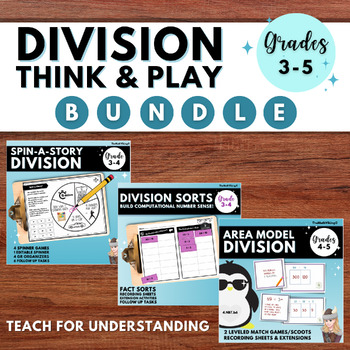Division Games & Activities Bundle: Hands-on reasoning build thinking classrooms
- Zip
Products in this Bundle (3)
Bonus
Description
Context and word problems are a great way to introduce division and this layers in student choice and fun! Spin the spinner to get context and number pairs for your student created stories! Kids who can write word problems, can solve them!
Then try the division fact sorts, with lots of options for thinking and sorting division sentences. "odd quotients/even quotients" or "Will have a remainder/won't have a remainder" So many options to get your kids reasoning!
The area model match games are one of my bestsellers! They are fun AND so helpful to help learners understand how this visual way of dividing small or large numbers builds number sense and mental math skills! (it's also setting the stage for algebra in a few short years)
Please check out the individual listings for details, pics and videos. Find me at themathvikingatgmaildotcom for questions. Feel free to ask for 100 photos to inspire real world division (and multiplication) stories. :)
For a FREE download of 100 Photos for Problem Solving, visit: TheMathViking.Com
Thank you for exploring math with me!
Math Viking
themathviking at gmail dot com
Be sure to FOLLOW ME here for new resources and TPT sales!
You definitely want to subscribe to TheMathViking.Com hundreds of engaging math freebies!!
PROBLEM SOLVING with actual thinking:
- Grade 3/4 Numberless Sort & Solve
- Grade 3-6 Word Problem Generator: Create Your Own!
- Numberless Fraction Word Problem Sort & Solve (digital and printable)
Daily Write & Wipe Number Sense Templates:
- Grade 3-4 Number of the Day/ Number Sense Templates All Year Long
- Grade 4-6 Number of the Day REASONING templates for whole numbers, fractions and decimals
Fraction Exploration:
- Hiding Fractions: My First Fraction Game!
- Fraction Cover Up!
- Fraction Battle Royale
- Fraction Area Fun with Beach Balls
- Fraction Daily Number Sense Write & Wipe Templates
- Fraction Warm Up Teaching Templates
Enrichment Projects & Games:
- Third Grade Printable Enrichment Packets
- 25 Different Mastermind Games for Holiday Fun & More!
- 5 Enrichment Project Bundle!
- Pico Fermi Bagels Freebie
Multiplication:
- Introduction & Mastery of the Distributive Property Bundle
- Multiplication Daily Number Sense Templates
- Hands-On Shake & Spill Multiplication Game: Distributive Property
- Prime & Composite Games for Thinking Classrooms
- FREE Fact Fluency Brag Tags & Progress Charts
- Multiplication Double & Half Game/Strategy Pack
PROBLEM SOLVING with actual thinking:
- Grade 3/4 Numberless Sort & Solve
- Grade 3-6 Word Problem Generator: Create Your Own!
- Numberless Fraction Word Problem Sort & Solve (digital and printable)
Math Classroom Decor/Anchor Charts:
Which One Doesn't Belong?
Digital Notebooks
Google Slides Instructional Support
Grades 4-8 Enrichment Packets:
- Decimal Enrichment Printable Packets
- Area Puzzle Challenge Packets
- Fraction Challenge Packets
- Algebraic Puzzles Enrichment Packets
- Place Value Packets
- Spiraled Packet A with Cover Page
- Spiraled Packets B/C/D/E with Cover Pages
- All Topic Packets & Spiraled Packets Bundle
All rights reserved by The Math Viking© Copyright Information: Purchase of this unit entitles the purchaser the right to reproduce this pack for ONE classroom use only. If you plan on sharing with others, please purchase an additional license. Thank you!!





